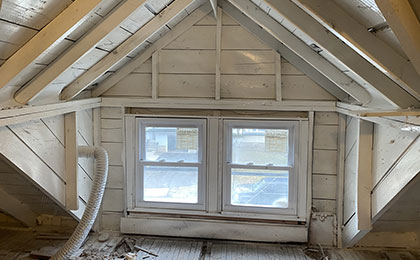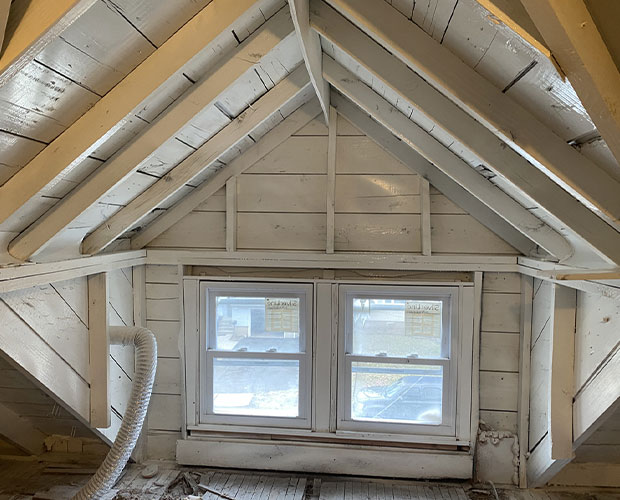
Mold in the Attic: What Every Homeowner Needs to Know
Research shows that nearly 50% of households across America have encountered mold in their attics. Those are striking numbers, aren't they?
Attics rank among the most common areas where mold grows in a home. This means that almost every second house in the USA could face this problem. What's more surprising is that many homeowners remain completely unaware of it.
Mold in an attic doesn't just harm the property's structure - it can also lower a home's value by 20-30% during an evaluation. Now think about this: if mold can affect the value of your property so drastically, imagine the potential toll it could take on your health.
That's why it's crucial to understand the causes of attic mold. By doing so, you can not only stop it in its tracks but also prevent it from coming back.
Why Does Mold in the Attic Occur So Frequently?
The attic is a unique part of the house, positioned within the roof to shield the home from all types of weather conditions.
Despite its crucial role, it often suffers from neglect and insufficient maintenance. Attics typically receive attention only when water droplets are seen falling from the ceiling, mold or stains become visible, or ventilation issues arise.
A critical factor to consider is that roof rafters and plywood - common attic materials - are made of wood. Wood has its advantages: it's porous, breathable, lightweight, and sturdy. However, these same qualities make it prone to microbial growth, particularly when moisture and humidity are not adequately controlled.
This vulnerability becomes especially apparent during seasonal changes and winter months, where fluctuating temperatures and increased humidity in many regions of America create ideal conditions for mold growth. Roof leaks further exacerbate this problem, making attics prime spots for microbial issues.
What Are the Most Common Causes of Mold in the Attic?
To fully understand this issue, let's examine the primary causes that contribute to microbial growth in the attic. Some of these problems can remain hidden for years, only becoming apparent when homeowners are forced to address an attic-related issue. While certain causes are more obvious, others are harder to detect but equally important to address:
1. Roof Leaks
Roof leaks are one of the most apparent and frequent reasons for moisture in the attic. Two major factors contribute to these leaks: time and external forces. Even the most durable insulation materials can deteriorate over time, losing their ability to protect against water infiltration. Temperature fluctuations significantly affect the roof's surface, causing it to expand and contract, which eventually results in cracks.
This is particularly true when debris, hail, or other external objects hit areas already weakened by age or harsh weather. These leaks allow moisture to penetrate the attic space, creating the ideal conditions for mold to thrive and microbial growth to take hold.
2. Improper Attic Ventilation
Poor ventilation is a major contributor to microbial growth, often going undetected for years. This issue commonly occurs when ridge vents are installed without properly functioning soffit vents or when the existing soffit vents are blocked. Insufficient venting is another frequent problem, as homes often fail to meet building codes, which typically recommend 1 square foot of ventilation for every 100 square feet of attic space.
Without adequate ventilation, the attic can become depressurized, pulling warm, moisture-laden air from the interior of the home during colder months. When this warm air meets the cold underside of the roof deck, it condenses into water. Over time, this moisture accumulates, saturating the wooden surfaces and providing the perfect environment for mold blooms to develop and spread.
3. Air Leaks in the Attic Floor
Air leaks are often hidden beneath layers of insulation, making them difficult to spot. They commonly occur around plumbing pipes, bathroom fixtures, wiring holes, and the tops of walls. During the winter months, warm air from the home's furnace escapes through these gaps, bringing moisture along with it.
Modern furnaces equipped with humidifiers can worsen this issue by adding even more moisture to the air, which inevitably migrates into the attic. This ongoing cycle of moisture accumulation promotes microbial growth and creates further structural concerns.
4. Improper Bathroom or Kitchen Fan Exhaust
Dryer vents, kitchen exhaust fans, and bathroom fans are specifically designed to expel moisture outside the home. However, when these vents terminate inside the attic instead of outdoors, they release significant amounts of moisture directly into the attic space.
Plumbing stacks located in the attic are another common source of condensation. Over time, this additional moisture can lead to mold growth, further exacerbating microbial issues. Improperly terminated plumbing stacks can also emit hazardous gases, posing serious health risks alongside the potential for structural deterioration.
How Do You Remove Mold from Your Attic?
Once the sources of moisture in your attic have been identified and addressed, the next step is to remove the attic mold. This process involves carefully eliminating every visible mold patch found during the inspection and resolving moisture and humidity issues.
Proper techniques, solutions, and application methods are critical. Mistakes at this stage will not only fail to eradicate the mold but may even create new moisture issues, which can trigger future mold problems. The mold removal process might seem straightforward, but it requires precision:
- Containment: Protecting the rest of your home from mold contamination is crucial. Proper containment of the work zone prevents mold spores from spreading during the removal process, keeping your living space safe and clean.
- Mold Removal: Addressing mold in hard-to-reach areas is essential for efficient and thorough removal. Paying attention to small details ensures the job is done right and sets the foundation for long-term success.
- Mold Prevention: Taking steps to prevent mold from returning solidifies the work done. By using the right methods and solutions, you can safeguard your attic from future issues and maintain a healthier home environment.
Each step of the process might look simple, but it requires the right know - how and attention to get it done effectively. Deciding how large the containment area should be and where to focus comes from experience - especially when it comes to identifying spots where mold likes to settle, even in hard-to-see areas. This understanding is what separates a thorough mold removal from one that misses the mark.
When it comes to prevention, the techniques used to stop mold from coming back are backed by years of expertise. These steps are designed to keep your home mold-free and your living environment healthier for the long run.
The Final Word on Attic Mold
Attic mold can truly be the Achilles' heel of any home, highlighting the importance of a thorough inspection and thoughtful evaluation of the issue. Mishandling the situation can spread mold spores to other areas of your home, leading to more contamination and potential health concerns.
Did you know that 25% of Americans are predisposed to mold-related illnesses? This means that one in four families could be affected by airborne mold if the problem isn't addressed properly and in time.
Treating attic mold isn't just about fixing a problem - it's about protecting your home and loved ones. Professional mold remediation service from Mold Act offers a reliable, effective solution. With expert help, you can save time, effort, and money while ensuring the issue is handled right the first time.
Cooperation with our professionals allows homeowners to focus on what they do best, leaving the intricate work of mold removal to those with the expertise and experience to do it thoroughly. By working together, you not only safeguard your home's value but also create a healthier living environment for your family. After all, a properly treated attic means peace of mind and long-term benefits.



Mold Remediation Services

